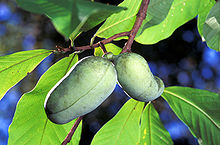
Back أزيمينة Arabic ازيمينه ARZ Asimina CEB Muďoul Czech Papau German Aɖuba EE Asimina Spanish آسیمینا Persian Papavit Finnish Asimina French
| Asimina | |
|---|---|

| |
| Asimina triloba (common pawpaw) in fruit | |
| Scientific classification | |
| Kingdom: | Plantae |
| Clade: | Tracheophytes |
| Clade: | Angiosperms |
| Clade: | Magnoliids |
| Order: | Magnoliales |
| Family: | Annonaceae |
| Subfamily: | Annonoideae |
| Genus: | Asimina Adans. (1763) |
| Type species | |
| Asimina triloba (L.) Dunal
| |
| Synonyms[1] | |
| |
Asimina is a genus of small trees or shrubs described as a genus in 1763.[2][3] Asimina is the only temperate genus in the tropical and subtropical flowering plant family Annonaceae.[4] Asimina have large, simple leaves and large fruit. It is native to eastern North America and collectively referred to as pawpaw. The genus includes the widespread common pawpaw Asimina triloba, which bears the largest edible fruit indigenous to the United States.[5] Pawpaws are native to 26 states of the U.S. and to Ontario in Canada.[5][6] The common pawpaw is a patch-forming (clonal) understory tree found in well-drained, deep, fertile bottomland and hilly upland habitat. Pawpaws are in the same plant family (Annonaceae) as the custard apple, cherimoya, sweetsop, soursop, and ylang-ylang;[7] the genus is the only member of that family not confined to the tropics. Fossils date to the Cretaceous.[8]
- ^ Asimina Adans. Plants of the World Online. Retrieved 4 June 2024.
- ^ Adanson, Michel. 1763. Familles des Plantes 2: 365 in French
- ^ "Tropicos, Asimina Adans".
- ^ Huang, Hongwen; Layne, Desmond; Kubisiak, Thomas (July 2000). "RAPD Inheritance and Diversity in Pawpaw (Asimina triloba)". Journal of the American Society for Horticultural Science. 125 (4): 454–459. doi:10.21273/JASHS.125.4.454.
- ^ a b "Pawpaw Description and Nutritional Information". Archived from the original on 19 July 2011. Retrieved 14 July 2011.
- ^ Flora of North America: Asimina triloba. "Asimina triloba". Flora of North America. Retrieved 13 July 2011.
- ^ Boning, Charles R. (2006). Florida's Best Fruiting Plants: Native and Exotic Trees, Shrubs, and Vines. Sarasota, Florida: Pineapple Press, Inc. pp. 172–173. ISBN 978-1-56164-372-1.
- ^ Peppe, Daniel J.; Erickson, J. Mark; Hickey, Leo J. (May 2007). "Fossil leaf species from the Fox Hills Formation (Upper Cretaceous: North Dakota, USA) and their paleogeographic significance". Journal of Paleontology. 81 (3): 550–567. Bibcode:2007JPal...81..550P. doi:10.1666/05067.1. ISSN 0022-3360.